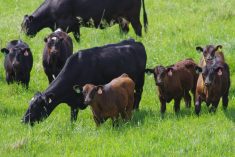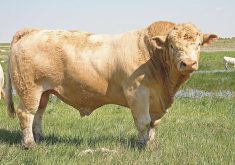Forage and Livestock Agronomist Megan Balascak describes silage corn trials at Westlock.ALEXIS KIENLEN
BY ALEXIS KIENLEN
AF STAFF |TAWATINAW
One of the advantages of producer-run research is that the producers get to choose the projects. That’s how it works with the Gateway Research Organization (GRO) based in Westlock, a non-profit, producer-run organization with the board of directors determining the areas of research. GRO is a member of the Agricultural Research Extension Council of Alberta and holds an annual field day and tour. This year’s showed some regional variety trials, as well as trials requested or suggested by area producers.
Read Also

Grazing ‘sweet spot’ boosts pasture performance
Timing-focused approach to pasture management touted to boost forage growth, livestock gains while also cutting farmer labour and inputs
Corn
Corn silage is becoming more popular among producers in the Westlock region and production has tripled in the past three years. As a result, GRO has expanded its corn silage variety trials from four varieties to six. “Guys are really discovering the feed value. It’s not that hard to grow and there are not too many changes you need to make for it to work for you,” said Megan Balascak, forage and livestock agronomist with GRO. Pioneer 7213 is a variety that seems to be doing well in the Westlock conditions.
In another trial, GRO is experimenting to determine the ideal row spacing for corn, with plots and eight and 30 inches.
“The eight-inch spacing is just too crowded and too clustered and they compete too much,” said Balascak. “But some guys think that if they plug every second row of their drills that they will nix that. But you can see that it is still clustered.”
Andrea Fox-Robinson, GRO’s general manager and crop agronomist, described another trial where Roundup Ready corn was sprayed at the two-, four-and eight-leaf stages.
“You can see that there’s a slight height difference between the early and the late, but we’re just trying to show that getting weeds under control early really does make a difference in that corn getting up there,” Fox-Robinson said. “It’s not the glaring difference that we wanted to see, but there is a difference, so we’ll just stress the importance of getting your weeds under control as early as possible to help the growth.”
Pulses and cereals
In another trial, Balascak is experimenting with a combination of pulses and cereal crops for silage. She used a combination of Murphy oats, Vivar barley, Cooper peas and Pronghorn triticale. The purpose of the trial is to see if the peas will increase the protein for background feeding. “Anything with peas has a high protein, while anything with the Vivar barley has a high energy too,” said Balascak.
The mixes are made by seeding peas at 75 per cent of their normal rate, and the cereals at 50 per cent of their normal rate. Everything is harvested depending on the maturity date of the cereals. Other trials included a barley silage trial, which showed good results from CDC Cowboy and Seebe. CDC Austenson also showed promise as a good, two-row feed barley.
Triticale
Triticale varieties doing well in the Westlock trials include Pronghorn and AC Ultima. Balascak described the crop as low management to grown, but high management for feeding. Triticale can also survive on less moisture and less fertilizer than oats or barley.
The crop is low in calcium, and producers should watch out for the development of milk fever in cattle if they choose to feed triticale.
Pronghorn and AC Ultima are awned varieties, so producers may want to be careful with maturity when they are feeding these to cattle.
There are several reduced-awn varieties, such as Bunker, which can be used for swath grazing.
“Triticale is also hard to chop if you’re using it for silage, so it takes a little care and can be hard on machinery,” said Balascak. “It seems to be a good crop nutritionally, so it’s a good choice even if it is more work.”
GRO has three research sites; one in Stony Plain, one in Neerlandia, and one in Tawitanaw. There are about eight crop trials and SeCan variety trials at the Neerlandia site, and about 10 trials at the Tawitanaw site.
GRO runs trials and offers extension services designed to assist area producers. They also offer consultations, workshops, field days and collaborate with the Agricultural Research Extension Council of Alberta. All research trials were conducted on land donated by area producers.
———
“Guysarereally
discovering(corn’s)feed value.It’snotthathard togrowandthereare nottoomanychanges youneedtomakeforitto workforyou.”
MEGAN BALASCAK
GATEWAY RESEARCH ORGANIZATION














